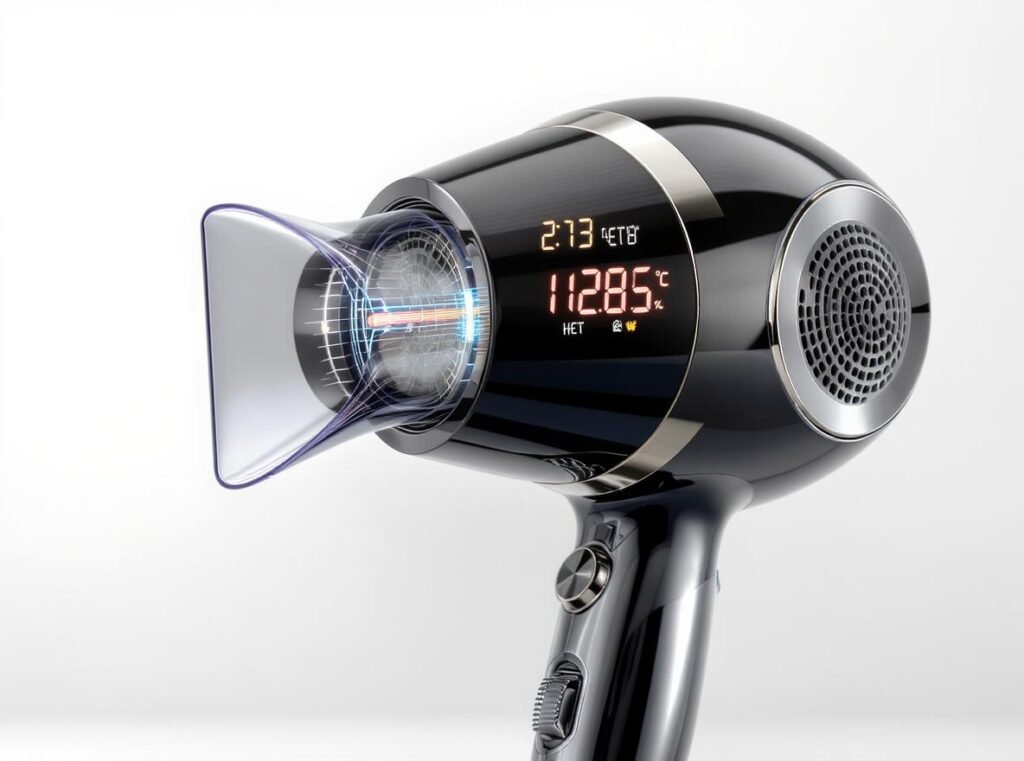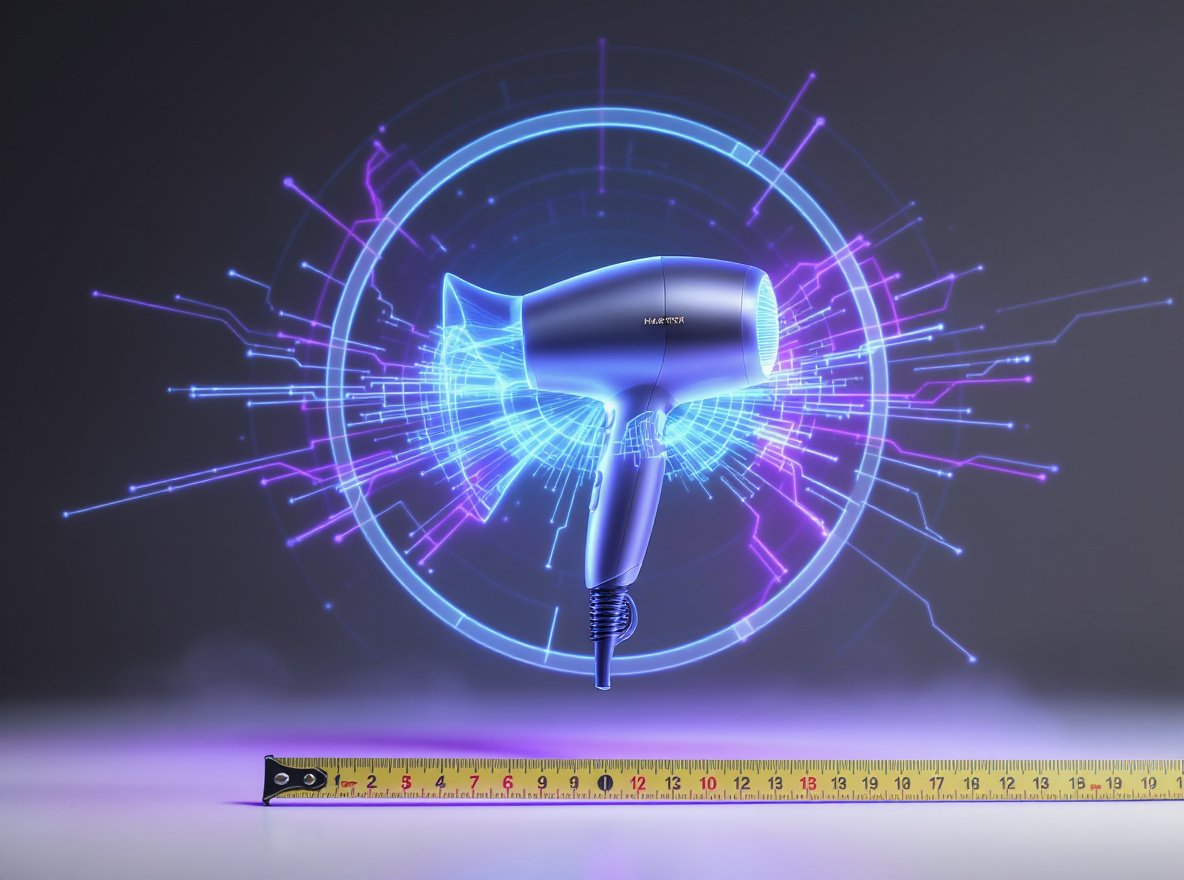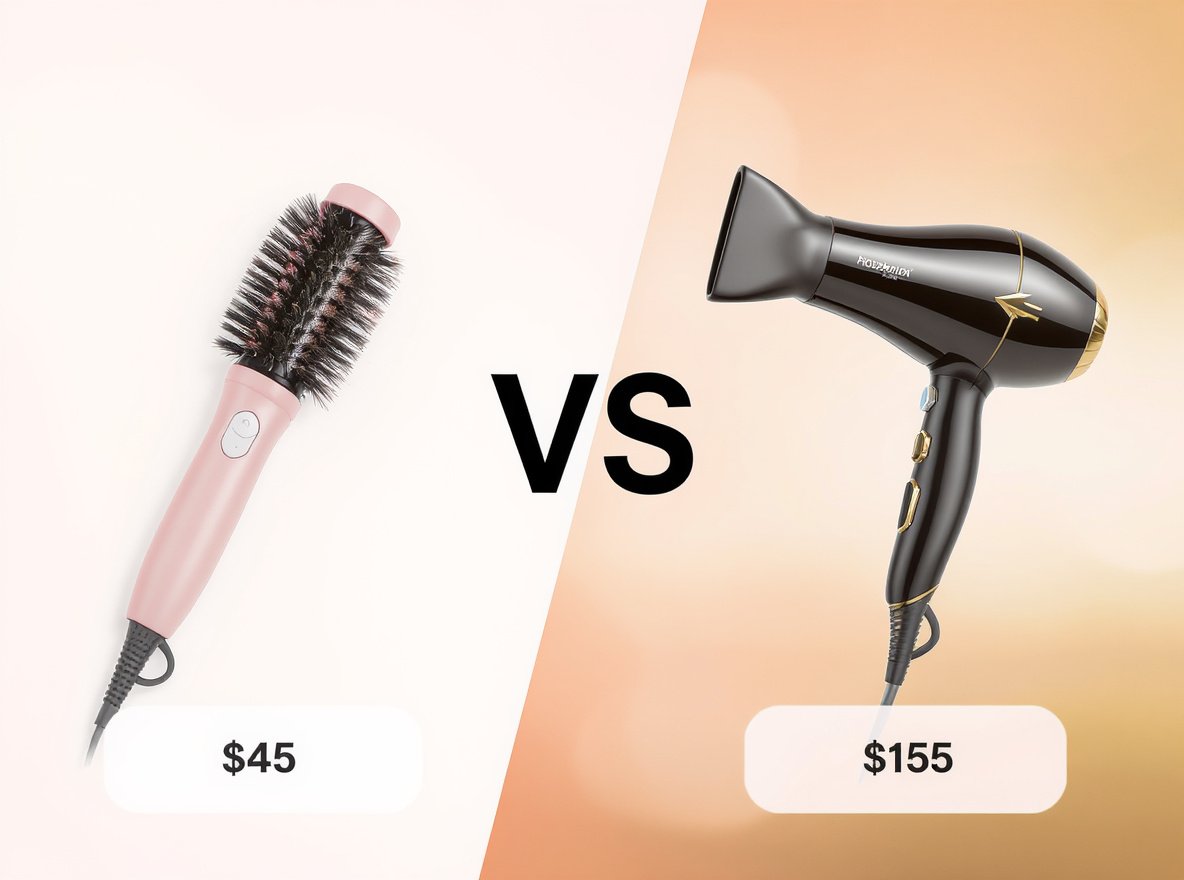Choosing the wrong hair dryer temperature can damage your hair, leaving it dry and brittle. Many people unknowingly use excessive heat that causes long-term harm to their hair structure and scalp health.
The optimal hair dryer temperature ranges from 80-140°F (27-60°C) for most hair types, with fine hair requiring lower settings and thick hair handling up to 140°F (60°C). Always start with the lowest effective temperature and use cool air to finish styling.
Understanding the right temperature settings will help you achieve salon-quality results while protecting your hair from heat damage.
Table of Contents
ToggleHow Hot Do Hair Dryers Actually Get?
Understanding your hair dryer’s temperature range is crucial for safe styling. Most people underestimate how hot these devices can become, which often leads to unintentional heat damage.
Hair dryers typically heat air between 80°F (27°C) and 140°F (60°C) depending on the setting and model. At maximum heat, they can reach up to 140°F (60°C), which is hot enough to potentially damage both your hair and scalp if used improperly.
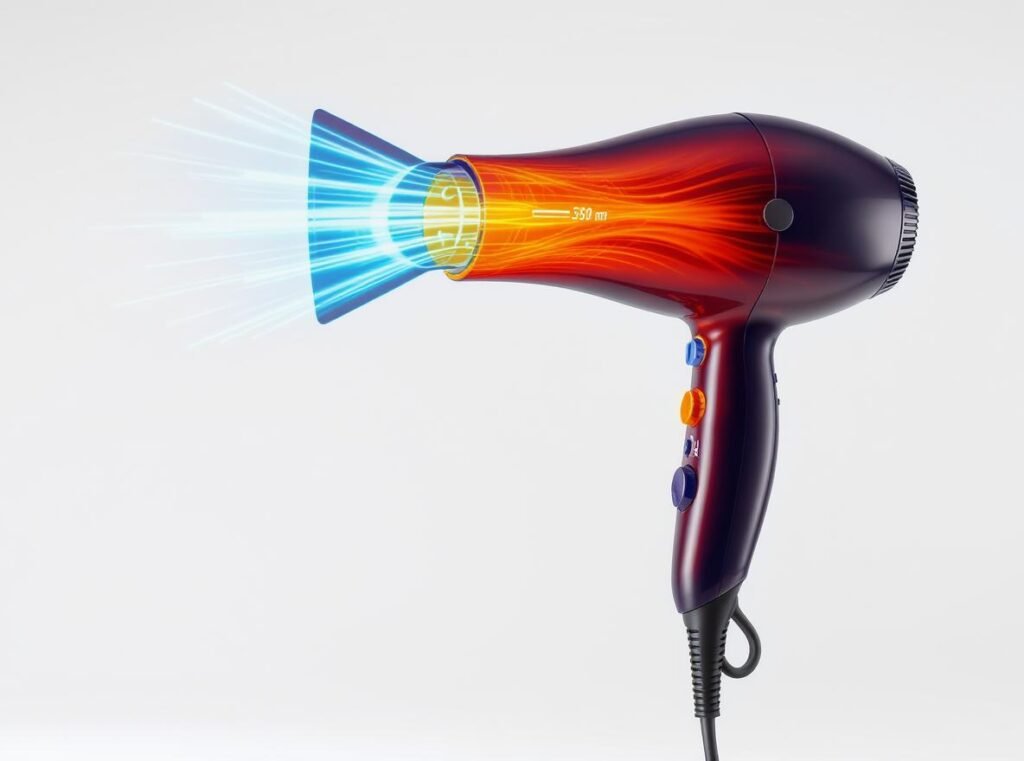
Most consumer hair dryers operate within the 80-140°F range, with some professional models offering more precise temperature control. The heat output depends on several key factors that affect your styling experience.
Temperature variations are influenced by:
- Heat settings: Low settings typically reach 80-100°F, while high settings can reach 140°F
- Wattage: Higher wattage models generate more consistent heat distribution
- Distance from hair: Heat intensity decreases significantly with distance from the scalp
- Airflow speed: Faster airflow can make lower temperatures more effective for drying
Professional-grade hair dryers often feature advanced temperature regulation systems, such as NTC (Negative Temperature Coefficient) technology, which monitors and adjusts heat output in real time to prevent overheating and damage.
Modern high-speed hair dryers like the Conason P1C are designed with intelligent temperature control that maintains optimal heat levels while preventing dangerous temperature spikes that can harm your hair.
What Temperature Should I Use for My Hair Type?
Different hair types require specific temperature ranges to achieve optimal results without damage. Your hair’s thickness, texture, and condition determine the ideal heat setting for your styling routine.
Fine or damaged hair should use low heat settings, medium or wavy hair works best at medium heat for quicker drying, and thick or coarse hair can handle high heat for faster drying, but keep high-heat sessions short and always use a heat protectant.
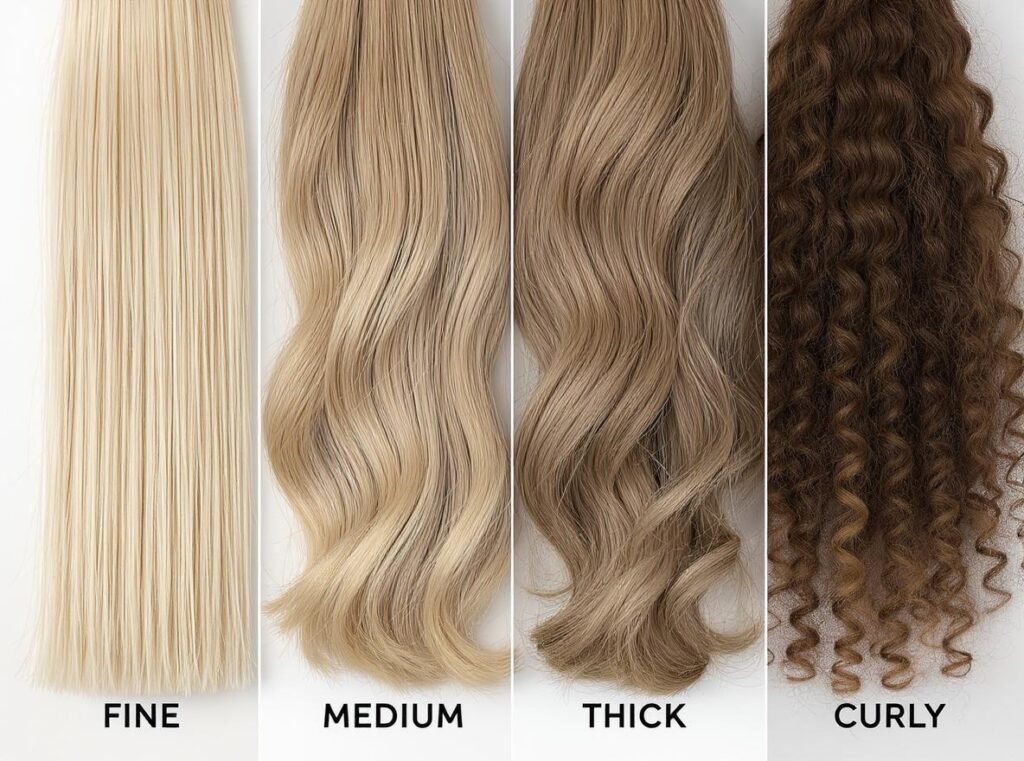
Temperature Guidelines by Hair Type
| Hair Type | Recommended Setting | Temperature Range | Special Considerations |
|---|---|---|---|
| Fine/Thin | Low heat | 80-100°F (27-38°C) | Most susceptible to damage, use heat protectant |
| Medium/Wavy | Medium heat | 100-120°F (38-49°C) | Balance between efficiency and protection |
| Thick/Coarse | High heat (short sessions) | 120-140°F (49-60°C) | Can withstand higher heat but limit exposure time |
| Damaged/Processed | Low heat only | 80-100°F (27-38°C) | Chemically treated hair needs gentle care |
| Curly | Low-medium heat | 90-110°F (32-43°C) | Use diffuser attachment for best results |
Fine, damaged, or chemically treated hair is more susceptible to heat damage, so lower temperatures are safer for maintaining hair health and preventing breakage.
Thick, healthy hair can withstand higher temperatures for short periods, but prolonged high heat can still cause damage even to resilient hair types. The key is finding the minimum effective temperature for your specific hair needs.
Why Does Hair Type Matter for Temperature Selection?
Hair structure varies significantly between individuals, affecting how heat interacts with each strand. Understanding these differences helps you choose the most appropriate temperature for your specific needs and avoid unnecessary damage.
Different hair types have varying tolerances to heat due to structural differences in diameter, porosity, and cuticle density. Fine hair has fewer protective layers and absorbs heat quickly, while thick hair has more density but still requires careful temperature management.
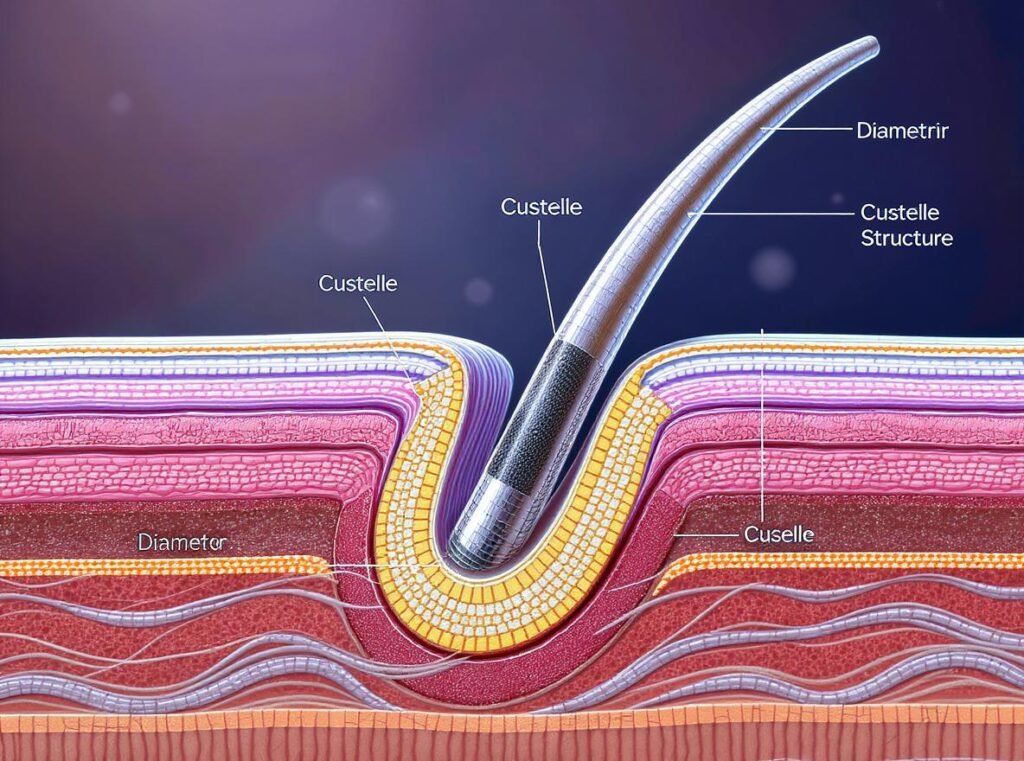
Fine hair characteristics that increase heat sensitivity:
- Smaller diameter means less protective structure
- Higher surface area to volume ratio increases heat absorption
- Delicate cuticle layer that damages easily
- Lower natural moisture retention capacity
Thick hair properties and considerations:
- Multiple cuticle layers provide some natural protection
- Dense structure requires more energy to heat through completely
- Can handle higher temperatures but damage still occurs with excessive heat
- May need higher heat for effective styling but risks remain
Chemical treatments like coloring, perming, or relaxing compromise hair structure regardless of natural thickness. These processes break down protein bonds, making hair more vulnerable to heat damage at any temperature level.
The protein (keratin) in hair can be damaged by excessive heat, leading to split ends, breakage, and loss of structural integrity. Understanding your hair’s unique characteristics helps prevent this type of damage.
When Should I Use High Heat vs Low Heat?
Strategic temperature adjustment throughout your drying process maximizes efficiency while minimizing damage. Professional stylists use different heat levels for different phases of the drying process to achieve optimal results.
High heat is best for thick hair that needs quick drying or when you’re in a hurry, but use sparingly and always finish with a cool shot. Low heat is ideal for fine, fragile, or damaged hair, or when you have extra time to dry your hair gently.
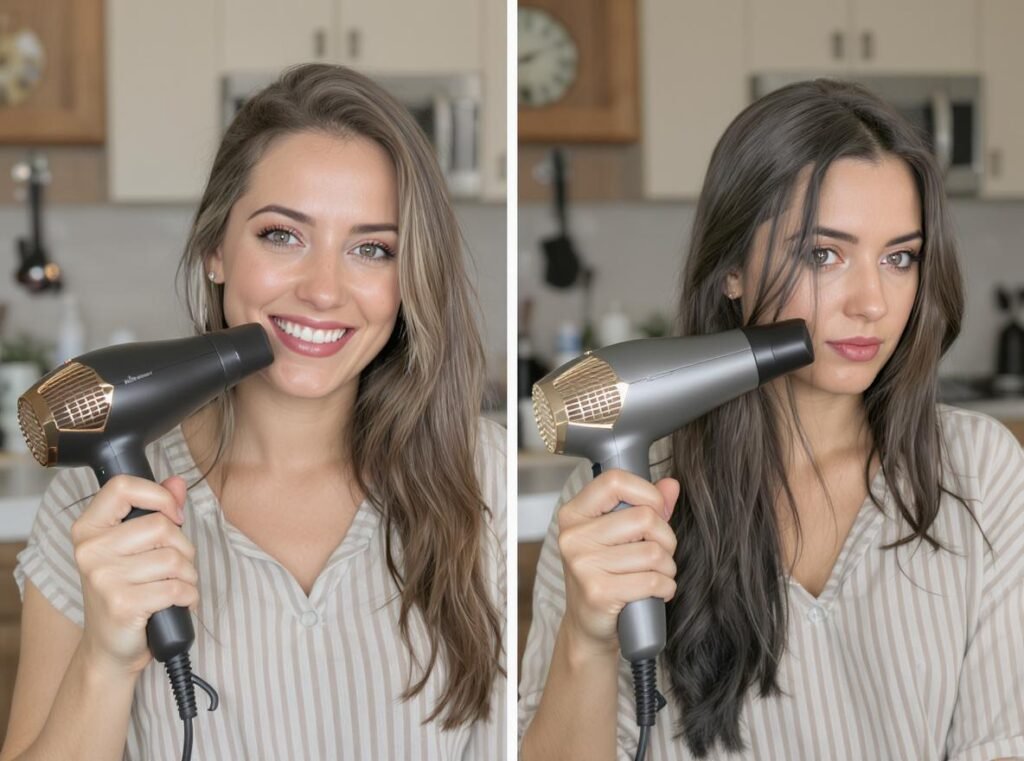
High Heat Applications
Use higher temperatures strategically for:
- Initial moisture removal: Quick drying of towel-dried thick hair
- Time-sensitive styling: When you need faster results
- Stubborn hair textures: Coarse hair that resists styling at lower temperatures
- Professional styling: Under controlled conditions with proper technique
Low Heat Benefits
Choose lower temperatures for:
- Daily maintenance: Regular styling without cumulative damage
- Damaged hair care: Preserving already compromised hair structure
- Gentle styling: When you have adequate time for slower drying
- Heat-sensitive scalp: Avoiding discomfort and irritation
Cool Shot Function
Always finish with cool air to:
- Set your style: Help styling hold longer throughout the day
- Close hair cuticles: Add shine and reduce frizz
- Reduce heat exposure: End styling session safely
- Seal moisture: Lock in hydration from styling products
The key principle is using the minimum effective temperature and finishing every styling session with cool air to set your look and protect your hair’s health.
What Are the Risks of Using Too Much Heat?
Excessive heat exposure causes both immediate and long-term damage to hair structure and scalp health. Understanding these risks helps you make informed decisions about temperature settings and styling frequency.
Excessive heat can cause dryness and brittleness by stripping moisture from hair, weaken hair structure by damaging keratin protein, create loss of shine making hair look dull, and while not typically causing permanent hair loss, frequent high heat can cause thinning and breakage.
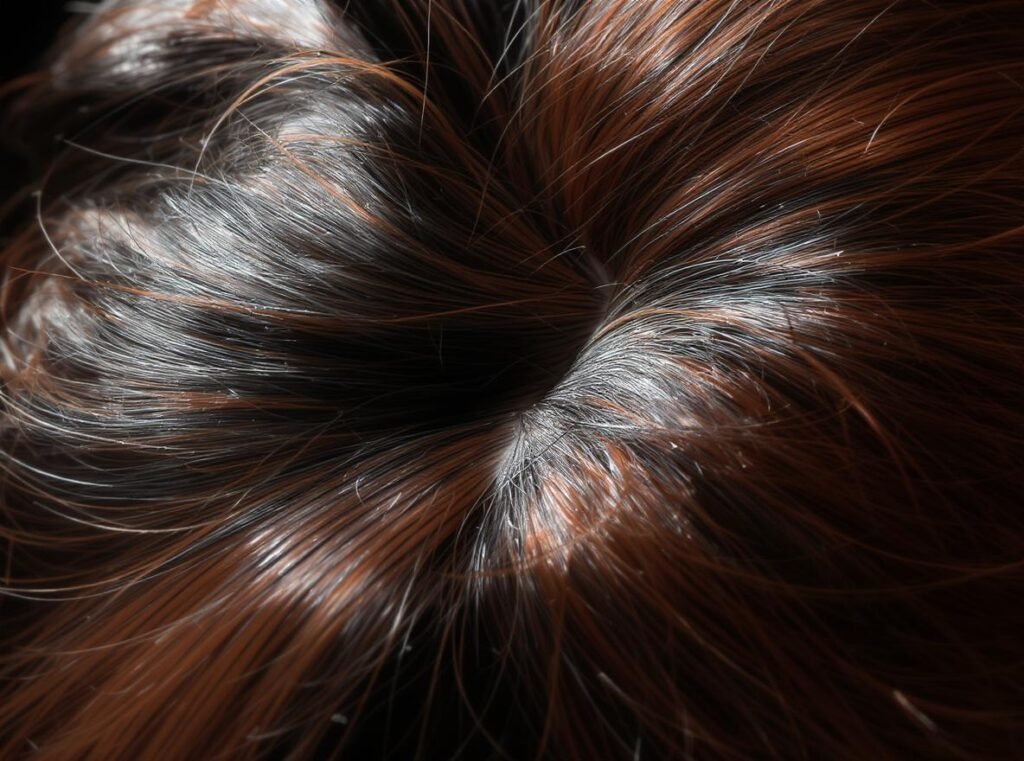
Immediate Heat Damage Effects
Heat damage occurs rapidly when temperatures exceed your hair’s tolerance:
- Moisture depletion: Hair becomes dry, rough, and prone to breakage
- Cuticle damage: Outer layer lifts, causing dull appearance and tangling
- Protein breakdown: Keratin structure weakens, reducing hair strength
- Scalp irritation: Direct heat can cause burns and sensitivity
Long-term Consequences of Heat Abuse
Consistent overheating creates cumulative damage that may be difficult to reverse:
- Structural weakening: Hair becomes increasingly fragile over time
- Split ends and breakage: Damaged hair shaft splits and breaks easily
- Texture changes: Natural properties may be permanently altered
- Thinning appearance: Breakage can mimic hair loss patterns
Heat Damage Prevention
| Risk Factor | Prevention Strategy | Expected Outcome |
|---|---|---|
| Daily high heat use | Limit frequency, use heat protectant | Reduced cumulative damage |
| – Temperature overheating | Monitor settings, use professional dryers | Consistent safe temperatures |
| Prolonged exposure | Keep dryer moving, use timer | Minimize contact time |
| No protection products | Always apply heat protectant spray | Chemical barrier against damage |
The damage from excessive heat builds up over time, making prevention much more effective than attempting to repair already damaged hair. Professional-quality dryers with temperature control help minimize these risks.
How Can I Protect My Hair from Heat Damage?
Heat protection involves multiple strategies beyond just temperature control. Combining proper techniques, protective products, and quality equipment creates a comprehensive approach to safe hair drying.
Essential protection includes using heat protectant products before styling, starting with damp rather than soaking wet hair, keeping the dryer moving to avoid concentrating heat, finishing with cool air, and limiting the frequency of heat tool use.
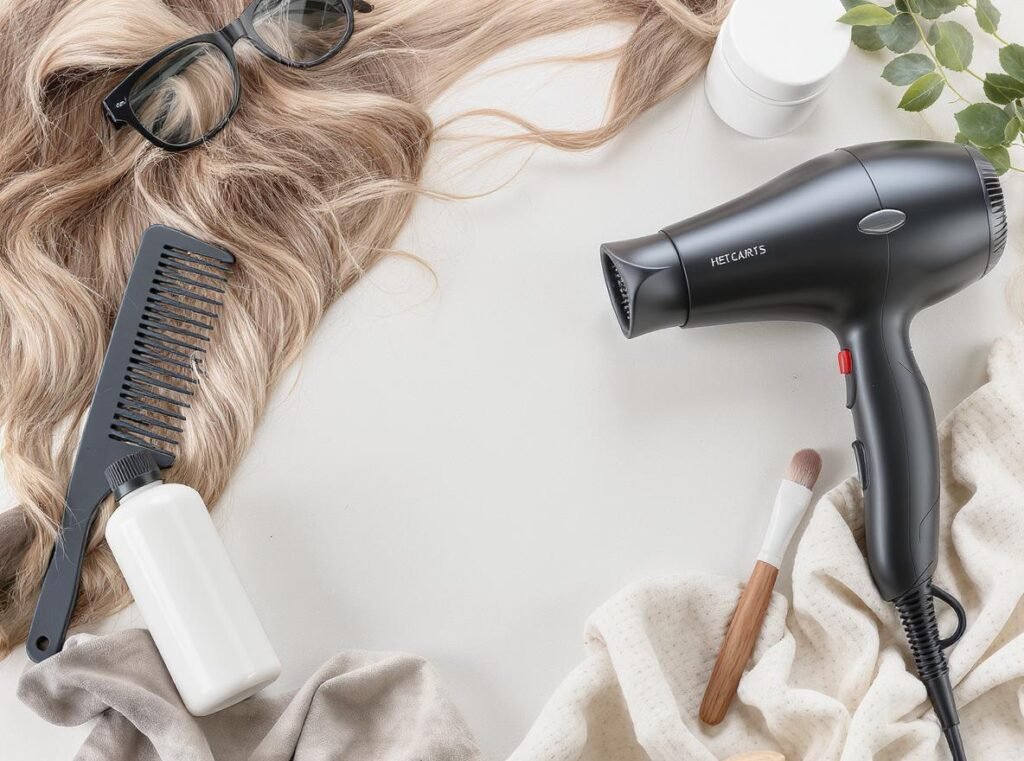
Pre-Styling Protection
Preparation significantly impacts heat damage prevention:
- Apply heat protectant: Use products designed to shield hair from heat before styling
- Start with proper dampness: Let hair air dry until about 90% dry before using a dryer
- Detangle gently: Use wide-tooth comb to prevent breakage during drying
- Section systematically: Work in manageable portions for even heat distribution
Safe Drying Techniques
Proper technique is as important as temperature selection:
Movement and Distance
- Keep the dryer moving: Don’t concentrate heat on one spot for too long
- Maintain proper distance: Hold dryer 6-8 inches from hair and scalp
- Use smooth motions: Move from roots to ends following hair’s natural direction
- Avoid direct scalp contact: Prevent burns and irritation
Finishing Techniques
- Cool shot completion: Use cool air to set style and add shine
- Gentle handling: Avoid rough brushing while hair is hot
- Gradual cooling: Allow hair to cool completely before final styling
- Moisture sealing: Apply leave-in treatments while hair is still warm
Equipment and Product Selection
Modern technology offers significant protection advantages:
- Advanced temperature control: Look for NTC technology or smart microprocessors for precise, stable heat
- Ionic technology: Helps reduce frizz and lock in moisture during drying
- Quality heat protectants: Invest in professional-grade protective sprays
- Professional equipment: Choose dryers with consistent temperature regulation
The Conason P1C incorporates advanced temperature regulation and ionic technology, providing the professional-level protection that helps prevent heat damage while achieving excellent styling results.
Do Professional Hair Dryers Make a Difference in Temperature Control?
Professional-grade hair dryers offer superior temperature management compared to basic consumer models. These differences significantly impact both styling results and hair health over extended use periods.
Yes, professional hair dryers often feature advanced temperature control systems like NTC technology that monitors and adjusts heat output in real time, providing more consistent and safer temperatures while helping reduce hair loss and heat-related damage.
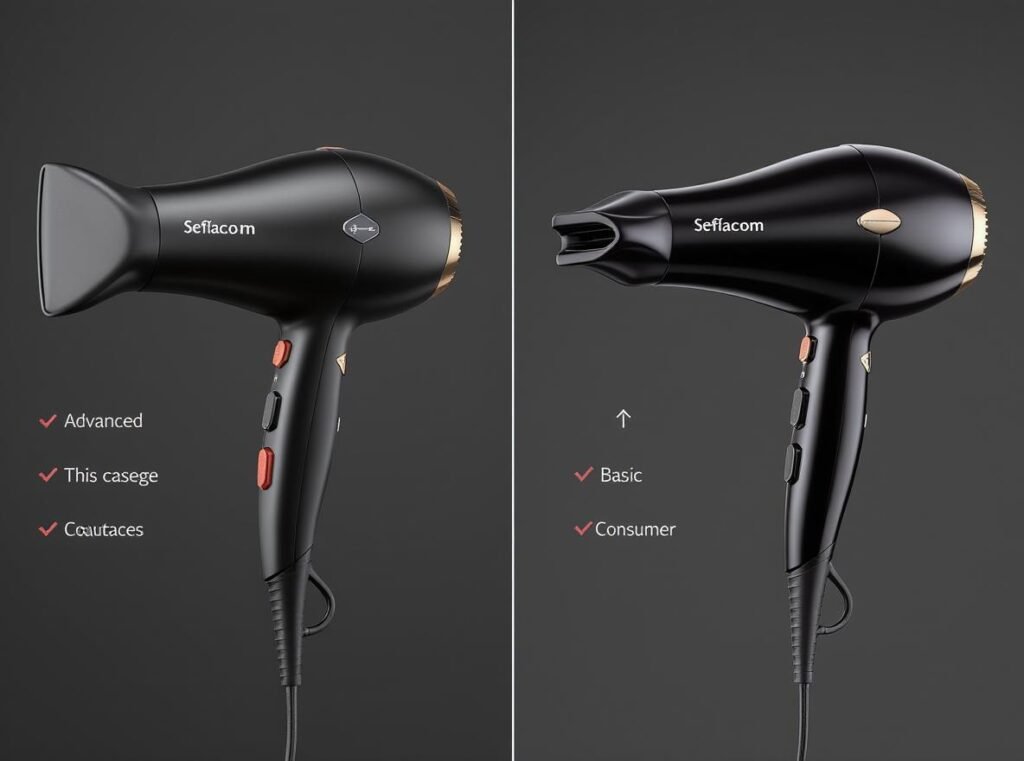
Advanced Temperature Technologies
Professional models incorporate sophisticated heating systems:
NTC (Negative Temperature Coefficient) Technology
- Monitors temperature continuously during use
- Automatically adjusts heat output to prevent overheating
- Maintains consistent temperature regardless of airflow changes
- Provides real-time protection against temperature spikes
Smart Microprocessor Control
- Calculates optimal heat distribution patterns
- Balances temperature with airflow for maximum efficiency
- Adapts to different hair types and styling needs
- Prevents dangerous temperature fluctuations
Professional vs Consumer Comparison
| Feature | Professional Models | Consumer Models |
|---|---|---|
| Temperature consistency | Stable throughout use | May fluctuate significantly |
| Heat settings | 3-5 precise levels | Usually 2-3 basic settings |
| Overheating protection | Advanced sensors and auto-shutoff | Basic thermal cutoffs |
| Heat distribution | Even across entire airflow | Potential hot spots |
| Durability | Designed for frequent use | Limited lifespan with heavy use |
Benefits for Hair Health
Professional temperature control systems provide measurable advantages:
- Reduced heat damage: Consistent temperatures prevent accidental overheating
- Faster drying times: Efficient heat distribution reduces total exposure
- Better styling results: Stable temperatures improve styling precision
- Longer hair health: Reduced cumulative damage over time
Investment Considerations
While professional dryers require higher initial investment, they offer long-term value through:
- Superior temperature management: Better protection for hair health
- Enhanced durability: Longer lifespan reduces replacement costs
- Professional results: Salon-quality styling capabilities
- Energy efficiency: Optimized heating reduces electricity usage
The Conason P1C represents professional-quality technology at wholesale prices, making advanced temperature control accessible for retailers who want to offer premium hair care solutions to their customers.
What Features Should I Look for in a Temperature-Controlled Hair Dryer?
Selecting the right hair dryer involves understanding which features contribute to optimal temperature management and overall hair health. Not all temperature controls offer the same level of protection and precision.
Essential features include multiple heat and speed settings for customization, advanced temperature regulation like NTC technology, cool shot button for setting styles, negative ion technology for frizz reduction, and ergonomic design for comfortable use during extended styling sessions.
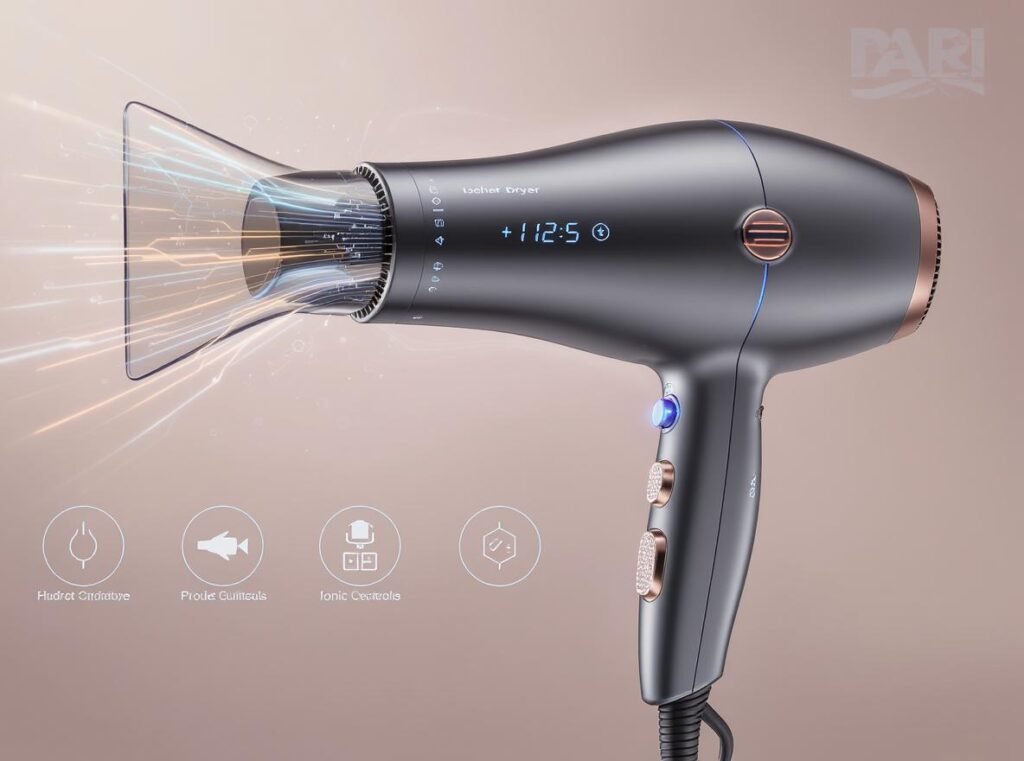
Critical Temperature Management Features
Multiple Heat and Speed Settings
- Minimum 3 heat levels: Allows precise temperature selection for different hair types
- Variable speed controls: Coordinates airflow with temperature for optimal results
- Clear indicators: Easy-to-read settings prevent accidental overheating
- Smooth transitions: Gradual temperature changes rather than sudden jumps
Advanced Temperature Regulation
- NTC technology: Negative Temperature Coefficient sensors for real-time monitoring
- Smart microprocessors: Intelligent heat distribution and automatic adjustments
- Overheating protection: Automatic shut-off systems prevent dangerous temperatures
- Temperature displays: Digital readouts for precise heat monitoring
Hair Health Technologies
Modern professional dryers incorporate multiple hair-protecting technologies:
Ionic Technology Benefits
- Negative ion generation: Breaks down water molecules for faster drying
- Frizz reduction: Smooths hair cuticles for shinier results
- Moisture retention: Helps lock in natural hair moisture
- Static elimination: Reduces flyaways and improves manageability
Heating Element Quality
- Ceramic technology: Distributes heat evenly across airflow
- Tourmaline coating: Generates additional negative ions naturally
- Infrared heating: Penetrates hair gently from inside out
- Multiple elements: Ensure consistent temperature distribution
Essential Safety and Convenience Features
| Feature Category | Key Elements | User Benefits |
|---|---|---|
| Safety | Overheat protection, cool shot button | Prevents damage, sets styles |
| Comfort | Ergonomic design, lightweight build | Reduces fatigue during use |
| Versatility | Multiple attachments, cord length | Accommodates different styling needs |
| Durability | Professional-grade components | Long-term reliability and performance |
Technology Integration for Professional Results
Advanced models offer smart features that enhance temperature control:
- Memory settings: Remembers preferred temperature combinations
- Auto-pause sensors: Conserves energy and prevents overheating
- Heat balance systems: Coordinates temperature with airflow automatically
- Professional attachments: Concentrator nozzles and diffusers for specialized styling
Selection Criteria for Wholesale Buyers
When choosing hair dryers for retail customers, prioritize models that offer:
- Proven temperature control technology: Documented heat regulation systems
- Multiple hair type compatibility: Suitable for diverse customer needs
- Professional build quality: Durable enough for frequent use
- Competitive feature sets: Advanced capabilities at reasonable price points
The Conason P1C integrates many of these professional features, including intelligent temperature control, ionic technology, and multiple heat settings, making it an excellent choice for retailers serving customers who prioritize both hair health and styling performance.
Summary
Choosing the right hair dryer temperature is essential for maintaining healthy hair while achieving your desired style. Use low heat for fine or damaged hair, medium heat for normal hair types, and limit high heat exposure even on thick hair, always finishing with cool air to set your style and protect your hair.
Ready to offer your customers professional-quality hair drying with optimal temperature control? Explore our Conason P1C high-speed hair dryer featuring intelligent temperature management and ionic technology, or browse our complete hair dryer collection for wholesale opportunities. Contact us today to discuss bulk pricing and become a Conason distributor in your market.

